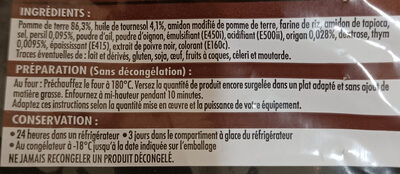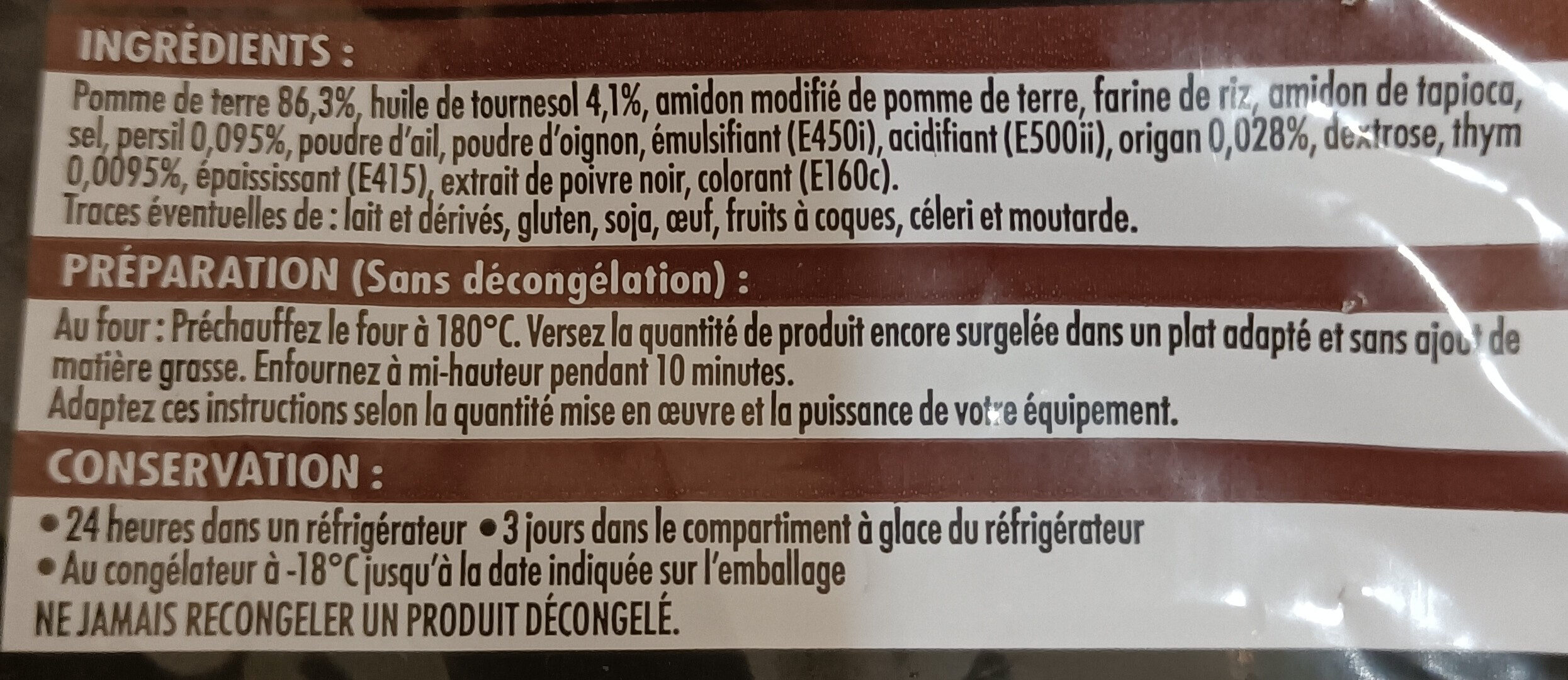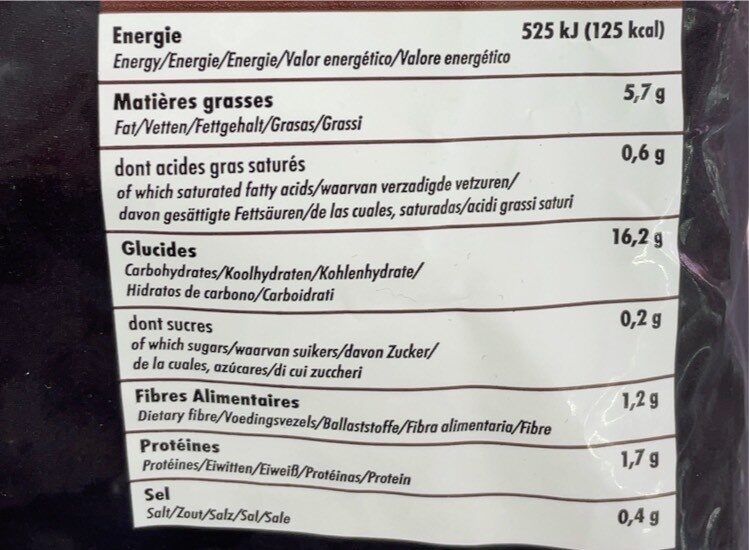Help us make food transparency the norm!
As a non-profit organization, we depend on your donations to continue informing consumers around the world about what they eat.
The food revolution starts with you!
Frites aux herbes - Lidl - 500g
Frites aux herbes - Lidl - 500g
This product page is not complete. You can help to complete it by editing it and adding more data from the photos we have, or by taking more photos using the app for Android or iPhone/iPad. Thank you!
×
Barkod: 3760032004915 (EAN / EAN-13)
Količina: 500g
Брендови: Lidl
Категорије: en:Frozen foods, en:Frozen fried potatoes, en:Frozen microwave fries
Oznake, sertifikati, nagrade: en:No preservatives, en:No colorings, en:No flavors
Poreklo sastojaka: Француска
Mesto u kojem se proizvodi ili prerađuje: Agen France
Prodavnice: Lidl
Matching with your preferences
Health
Sastojci
-
21 ingredients
: Pomme de terre 86,3%, huile de tournesol 4,1%, amidon modifié de pomme de terre, farine de riz, amidon de tapioca, sel, persil 0,095%, poudre d'ail, poudre d'oignon, émulsifiant (E450i), acidifiant (E500ii), origan 0,028%, dextrose, thym 0,0095%, épaississant (E415), extrait de poivre noir, colorant (E160c).Traces: Celer, Jaja, Pšenica, Mleko, Senf, Jezgrasto voće, Soja
Food processing
-
Ultra processed foods
Elements that indicate the product is in the en:4 - Ultra processed food and drink products group:
- Адитив: E14XX
- Адитив: E160c
- Адитив: E415
- Адитив: E450
- Ingredient: Boja
- Ingredient: Dekstroza
- Ingredient: Emulsifier
- Ingredient: Глукоза
- Ingredient: Zgušnjavači
Food products are classified into 4 groups according to their degree of processing:
- Neprerađena ili minimalno prerađena hrana
- Prerađeni kulinarski sastojci
- Prerađena hrana
- Ultra processed foods
The determination of the group is based on the category of the product and on the ingredients it contains.
Адитиви
-
E415
Xanthan gum: Xanthan gum -- is a polysaccharide with many industrial uses, including as a common food additive. It is an effective thickening agent and stabilizer to prevent ingredients from separating. It can be produced from simple sugars using a fermentation process, and derives its name from the species of bacteria used, Xanthomonas campestris.Source: Wikipedia (Енглески језик)
-
E500
Sodium carbonate: Sodium carbonate, Na2CO3, -also known as washing soda, soda ash and soda crystals, and in the monohydrate form as crystal carbonate- is the water-soluble sodium salt of carbonic acid. It most commonly occurs as a crystalline decahydrate, which readily effloresces to form a white powder, the monohydrate. Pure sodium carbonate is a white, odorless powder that is hygroscopic -absorbs moisture from the air-. It has a strongly alkaline taste, and forms a moderately basic solution in water. Sodium carbonate is well known domestically for its everyday use as a water softener. Historically it was extracted from the ashes of plants growing in sodium-rich soils, such as vegetation from the Middle East, kelp from Scotland and seaweed from Spain. Because the ashes of these sodium-rich plants were noticeably different from ashes of timber -used to create potash-, they became known as "soda ash". It is synthetically produced in large quantities from salt -sodium chloride- and limestone by a method known as the Solvay process. The manufacture of glass is one of the most important uses of sodium carbonate. Sodium carbonate acts as a flux for silica, lowering the melting point of the mixture to something achievable without special materials. This "soda glass" is mildly water-soluble, so some calcium carbonate is added to the melt mixture to make the glass produced insoluble. This type of glass is known as soda lime glass: "soda" for the sodium carbonate and "lime" for the calcium carbonate. Soda lime glass has been the most common form of glass for centuries. Sodium carbonate is also used as a relatively strong base in various settings. For example, it is used as a pH regulator to maintain stable alkaline conditions necessary for the action of the majority of photographic film developing agents. It acts as an alkali because when dissolved in water, it dissociates into the weak acid: carbonic acid and the strong alkali: sodium hydroxide. This gives sodium carbonate in solution the ability to attack metals such as aluminium with the release of hydrogen gas.It is a common additive in swimming pools used to raise the pH which can be lowered by chlorine tablets and other additives which contain acids. In cooking, it is sometimes used in place of sodium hydroxide for lyeing, especially with German pretzels and lye rolls. These dishes are treated with a solution of an alkaline substance to change the pH of the surface of the food and improve browning. In taxidermy, sodium carbonate added to boiling water will remove flesh from the bones of animal carcasses for trophy mounting or educational display. In chemistry, it is often used as an electrolyte. Electrolytes are usually salt-based, and sodium carbonate acts as a very good conductor in the process of electrolysis. In addition, unlike chloride ions, which form chlorine gas, carbonate ions are not corrosive to the anodes. It is also used as a primary standard for acid-base titrations because it is solid and air-stable, making it easy to weigh accurately.Source: Wikipedia (Енглески језик)
-
E500ii - Натријум хидрогенкарбонат
Sodium carbonate: Sodium carbonate, Na2CO3, -also known as washing soda, soda ash and soda crystals, and in the monohydrate form as crystal carbonate- is the water-soluble sodium salt of carbonic acid. It most commonly occurs as a crystalline decahydrate, which readily effloresces to form a white powder, the monohydrate. Pure sodium carbonate is a white, odorless powder that is hygroscopic -absorbs moisture from the air-. It has a strongly alkaline taste, and forms a moderately basic solution in water. Sodium carbonate is well known domestically for its everyday use as a water softener. Historically it was extracted from the ashes of plants growing in sodium-rich soils, such as vegetation from the Middle East, kelp from Scotland and seaweed from Spain. Because the ashes of these sodium-rich plants were noticeably different from ashes of timber -used to create potash-, they became known as "soda ash". It is synthetically produced in large quantities from salt -sodium chloride- and limestone by a method known as the Solvay process. The manufacture of glass is one of the most important uses of sodium carbonate. Sodium carbonate acts as a flux for silica, lowering the melting point of the mixture to something achievable without special materials. This "soda glass" is mildly water-soluble, so some calcium carbonate is added to the melt mixture to make the glass produced insoluble. This type of glass is known as soda lime glass: "soda" for the sodium carbonate and "lime" for the calcium carbonate. Soda lime glass has been the most common form of glass for centuries. Sodium carbonate is also used as a relatively strong base in various settings. For example, it is used as a pH regulator to maintain stable alkaline conditions necessary for the action of the majority of photographic film developing agents. It acts as an alkali because when dissolved in water, it dissociates into the weak acid: carbonic acid and the strong alkali: sodium hydroxide. This gives sodium carbonate in solution the ability to attack metals such as aluminium with the release of hydrogen gas.It is a common additive in swimming pools used to raise the pH which can be lowered by chlorine tablets and other additives which contain acids. In cooking, it is sometimes used in place of sodium hydroxide for lyeing, especially with German pretzels and lye rolls. These dishes are treated with a solution of an alkaline substance to change the pH of the surface of the food and improve browning. In taxidermy, sodium carbonate added to boiling water will remove flesh from the bones of animal carcasses for trophy mounting or educational display. In chemistry, it is often used as an electrolyte. Electrolytes are usually salt-based, and sodium carbonate acts as a very good conductor in the process of electrolysis. In addition, unlike chloride ions, which form chlorine gas, carbonate ions are not corrosive to the anodes. It is also used as a primary standard for acid-base titrations because it is solid and air-stable, making it easy to weigh accurately.Source: Wikipedia (Енглески језик)
Ingredients analysis
-
Без палмовог уља
No ingredients containing palm oil detected
-
Веганско
No non-vegan ingredients
-
Вегетаријанско
No non-vegetarian ingredients detected
-
Details of the analysis of the ingredients
: Pomme de terre 86.3%, huile de tournesol 4.1%, amidon modifié de pomme de terre, farine de riz, amidon de tapioca, sel, persil 0.095%, ail, oignon, émulsifiant (e450i), acidifiant (e500ii), origan 0.028%, dextrose, thym 0.0095%, épaississant (e415), extrait de poivre noir, colorant (e160c)- Pomme de terre -> en:potato - vegan: yes - vegetarian: yes - ciqual_food_code: 4003 - percent_min: 86.3 - percent: 86.3 - percent_max: 86.3
- huile de tournesol -> en:sunflower-oil - vegan: yes - vegetarian: yes - from_palm_oil: no - ciqual_food_code: 17440 - percent_min: 4.1 - percent: 4.1 - percent_max: 4.1
- amidon modifié de pomme de terre -> en:modified-potato-starch - vegan: yes - vegetarian: yes - ciqual_proxy_food_code: 9510 - percent_min: 1.93710582010584 - percent_max: 4.1
- farine de riz -> en:rice-flour - vegan: yes - vegetarian: yes - ciqual_food_code: 9520 - percent_min: 1.93710582010584 - percent_max: 4.1
- amidon de tapioca -> en:tapioca - vegan: yes - vegetarian: yes - ciqual_proxy_food_code: 9510 - percent_min: 0.43100000000002 - percent_max: 2.59389417989418
- sel -> en:salt - vegan: yes - vegetarian: yes - ciqual_food_code: 11058 - percent_min: 0.095 - percent_max: 0.4
- persil -> en:parsley - vegan: yes - vegetarian: yes - ciqual_proxy_food_code: 11014 - percent_min: 0.095 - percent: 0.095 - percent_max: 0.095
- ail -> en:garlic - vegan: yes - vegetarian: yes - ciqual_food_code: 11000 - percent_min: 0.028 - percent_max: 0.095
- oignon -> en:onion - vegan: yes - vegetarian: yes - ciqual_food_code: 20034 - percent_min: 0.028 - percent_max: 0.095
- émulsifiant -> en:emulsifier - percent_min: 0.028 - percent_max: 0.095
- e450i -> en:e450i - vegan: yes - vegetarian: yes - percent_min: 0 - percent_max: 0.095
- acidifiant -> en:acid - percent_min: 0.028 - percent_max: 0.095
- e500ii -> en:e500ii - vegan: yes - vegetarian: yes - percent_min: 0 - percent_max: 0.095
- origan -> en:oregano - vegan: yes - vegetarian: yes - ciqual_proxy_food_code: 11035 - percent_min: 0.028 - percent: 0.028 - percent_max: 0.028
- dextrose -> en:dextrose - vegan: yes - vegetarian: yes - ciqual_proxy_food_code: 31016 - percent_min: 0.0095 - percent_max: 0.028
- thym -> en:thyme - vegan: yes - vegetarian: yes - ciqual_food_code: 11070 - percent_min: 0.0095 - percent: 0.0095 - percent_max: 0.0095
- épaississant -> en:thickener - percent_min: 0 - percent_max: 0.0095
- e415 -> en:e415 - vegan: yes - vegetarian: yes - percent_min: 0 - percent_max: 0.0095
- extrait de poivre noir -> en:black-pepper-extract - vegan: yes - vegetarian: yes - ciqual_food_code: 11015 - percent_min: 0 - percent_max: 0.0095
- colorant -> en:colour - percent_min: 0 - percent_max: 0.0095
- e160c -> en:e160c - vegan: yes - vegetarian: yes - percent_min: 0 - percent_max: 0.0095
Nutritivne vrednosti
-
Good nutritional quality
⚠ ️Warning: the amount of fiber is not specified, their possible positive contribution to the grade could not be taken into account.⚠ ️Warning: the amount of fruits, vegetables and nuts is not specified on the label, it was estimated from the list of ingredients: 0This product is not considered a beverage for the calculation of the Nutri-Score.
Positive points: 1
- Proteins: 1 / 5 (value: 1.7, rounded value: 1.7)
- Fiber: 0 / 5 (value: 0, rounded value: 0)
- Fruits, vegetables, nuts, and colza/walnut/olive oils: 0 / 5 (value: 0.095, rounded value: 0.1)
Negative points: 2
- Energy: 1 / 10 (value: 525, rounded value: 525)
- Sugars: 0 / 10 (value: 0.2, rounded value: 0.2)
- Zasićene masne kiseline: 0 / 10 (value: 0.6, rounded value: 0.6)
- Natrijum: 1 / 10 (value: 160, rounded value: 160)
The points for proteins are counted because the negative points are less than 11.
Nutritional score: (2 - 1)
Nutri-Score:
-
Nutrient levels
-
Масти in moderate quantity (5.7%)
What you need to know- A high consumption of fat, especially saturated fats, can raise cholesterol, which increases the risk of heart diseases.
Recommendation: Limit the consumption of fat and saturated fat- Choose products with lower fat and saturated fat content.
-
Zasićena mast in low quantity (0.6%)
What you need to know- A high consumption of fat, especially saturated fats, can raise cholesterol, which increases the risk of heart diseases.
Recommendation: Limit the consumption of fat and saturated fat- Choose products with lower fat and saturated fat content.
-
Шећер in low quantity (0.2%)
What you need to know- A high consumption of sugar can cause weight gain and tooth decay. It also augments the risk of type 2 diabetes and cardio-vascular diseases.
Recommendation: Limit the consumption of sugar and sugary drinks- Sugary drinks (such as sodas, fruit beverages, and fruit juices and nectars) should be limited as much as possible (no more than 1 glass a day).
- Choose products with lower sugar content and reduce the consumption of products with added sugars.
-
Со in moderate quantity (0.4%)
What you need to know- A high consumption of salt (or sodium) can cause raised blood pressure, which can increase the risk of heart disease and stroke.
- Many people who have high blood pressure do not know it, as there are often no symptoms.
- Most people consume too much salt (on average 9 to 12 grams per day), around twice the recommended maximum level of intake.
Recommendation: Limit the consumption of salt and salted food- Reduce the quantity of salt used when cooking, and don't salt again at the table.
- Limit the consumption of salty snacks and choose products with lower salt content.
-
-
Hranljiva vrednost
Hranljiva vrednost As sold
for 100 g / 100 mlCompared to: en:Frozen foods Енергија 525 kj
(125 kcal)-28% Масти 5,7 g -29% Zasićena mast 0,6 g -86% Carbohydrates 16,2 g -20% Шећер 0,2 g -98% Fiber ? Протеин 1,7 g -46% Со 0,4 g +39% Fruits‚ vegetables‚ nuts and rapeseed‚ walnut and olive oils (estimate from ingredients list analysis) 0,095 %
Environment
-
Eco-Score B - Low environmental impact
The Eco-Score is an experimental score that summarizes the environmental impacts of food products.→ The Eco-Score was initially developped for France and it is being extended to other European countries. The Eco-Score formula is subject to change as it is regularly improved to make it more precise and better suited to each country.Life cycle analysis
-
Average impact of products of the same category: A (Score: 93/100)
Категорија: French fries or chips, frozen, raw, intended to be microwaved
Категорија: French fries or chips, frozen, raw, intended to be microwaved
- PEF environmental score: 0.16 (the lower the score, the lower the impact)
- including impact on climate change: 1.20 kg CO2 eq/kg of product
Stage Impact Agriculture
17.6 %Processing
12.2 %Ambalaža
20.9 %Transportation
15.9 %Distribution
22.7 %Consumption
10.7 %
Bonuses and maluses
-
Origins of ingredients with a medium impact
Bonus: +5
Environmental policy: +4
Transportation: +1
Origin of the product and/or its ingredients % of ingredients Impact Француска 100 %Medium
-
Missing packaging information for this product
Malus: -15
⚠ ️ The information about the packaging of this product is not filled in.⚠ ️ For a more precise calculation of the Eco-Score, you can modify the product page and add them.
If you are the manufacturer of this product, you can send us the information with our free platform for producers.
Eco-Score for this product
-
Impact for this product: B (Score: 79/100)
Производ: Frites aux herbes - Lidl - 500g
Life cycle analysis score: 93
Sum of bonuses and maluses: -10
Final score: 79/100 (The score of products with non-recyclable and non-biodegradable packaging materials is capped at 79 (grade B).)
-
Carbon footprint
-
Equal to driving 0.6 km in a petrol car
120 g CO² per 100g of product
The carbon emission figure comes from ADEME's Agribalyse database, for the category: French fries or chips, frozen, raw, intended to be microwaved (Source: ADEME Agribalyse Database)
Stage Impact Agriculture
12.5 %Processing
10.3 %Ambalaža
33.4 %Transportation
27.2 %Distribution
12.7 %Consumption
3.9 %
Ambalaža
-
Missing packaging information for this product
⚠ ️ The information about the packaging of this product is not filled in.Take a photo of the recycling information Take a photo of the recycling information
Transportation
-
Origins of ingredients
Origins of ingredients with a medium impact
Origin of the product and/or its ingredients % of ingredients Impact Француска 100 %Medium
Report a problem
-
Incomplete or incorrect information?
Category, labels, ingredients, allergens, nutritional information, photos etc.
If the information does not match the information on the packaging, please complete or correct it. Open Food Facts is a collaborative database, and every contribution is useful for all.
Data sources
Product added on од kiliweb
Last edit of product page on од .
Страницу производа такође уредио ecoscore-impact-estimator, openfoodfacts-contributors, toma-stupar, yuka.sY2b0xO6T85zoF3NwEKvlmxmSN38hhfAMiHjtXS6xfuiA8TpSs9v5YrHCqs.












